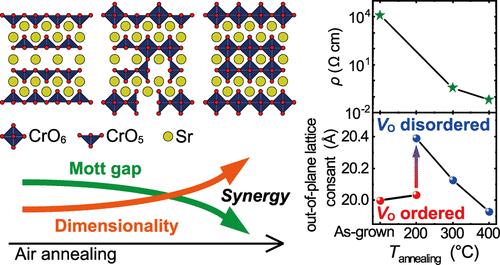Oxidation-Induced Giant Resistivity Change Associated with Structural and Electronic Reconstruction in Layered Sr3Cr2O7−δ Epitaxial Thin Films
IF 7
2区 材料科学
Q2 CHEMISTRY, PHYSICAL
引用次数: 0
Abstract
Ruddlesden–Popper-type Sr3Cr2O7−δ (001) epitaxial thin films with high crystallinity and flat surfaces are grown by pulsed laser deposition. The as-grown thin films exhibit transparent color and high resistivity, indicating the existence of a number of oxygen vacancies as well as Cr3+ ions. Air annealing causes a nonmonotonic variation in lattice constants and a color change to brownish due to the compensation of ordered oxygen vacancies as well as oxidation of the Cr3+ ions to Cr4+ ions. At the same time, the room temperature resistivity shows a large decrease exceeding 5 orders of magnitude. Synchrotron-radiation photoemission spectroscopy reveals a wider Mott gap for the Cr3+ ions than that for Cr4+ ions. Accordingly, the giant resistivity change is attributed to the synergistic effects of dimensionality variation in the electron conduction pathway and band-structure modulation, which depends on the Cr valence within the layered structure.

层状Sr3Cr2O7−δ外延薄膜氧化诱导的巨电阻率变化与结构和电子重构
采用脉冲激光沉积法制备了高结晶度、表面平整的ruddlesden - popper型Sr3Cr2O7−δ(001)外延薄膜。生长后的薄膜呈现出透明的颜色和高电阻率,表明存在大量氧空位和Cr3+离子。空气退火引起晶格常数的非单调变化,并由于有序氧空位的补偿以及Cr3+离子氧化为Cr4+离子而使颜色变为褐色。同时,室温电阻率大幅下降,降幅超过5个数量级。同步辐射光发射光谱显示,Cr3+离子的Mott隙比Cr4+离子的Mott隙更宽。因此,电阻率的巨大变化归因于电子传导路径的维数变化和带结构调制的协同效应,这取决于层状结构内的Cr价态。
本文章由计算机程序翻译,如有差异,请以英文原文为准。
求助全文
约1分钟内获得全文
求助全文
来源期刊

Chemistry of Materials
工程技术-材料科学:综合
CiteScore
14.10
自引率
5.80%
发文量
929
审稿时长
1.5 months
期刊介绍:
The journal Chemistry of Materials focuses on publishing original research at the intersection of materials science and chemistry. The studies published in the journal involve chemistry as a prominent component and explore topics such as the design, synthesis, characterization, processing, understanding, and application of functional or potentially functional materials. The journal covers various areas of interest, including inorganic and organic solid-state chemistry, nanomaterials, biomaterials, thin films and polymers, and composite/hybrid materials. The journal particularly seeks papers that highlight the creation or development of innovative materials with novel optical, electrical, magnetic, catalytic, or mechanical properties. It is essential that manuscripts on these topics have a primary focus on the chemistry of materials and represent a significant advancement compared to prior research. Before external reviews are sought, submitted manuscripts undergo a review process by a minimum of two editors to ensure their appropriateness for the journal and the presence of sufficient evidence of a significant advance that will be of broad interest to the materials chemistry community.
 求助内容:
求助内容: 应助结果提醒方式:
应助结果提醒方式:


